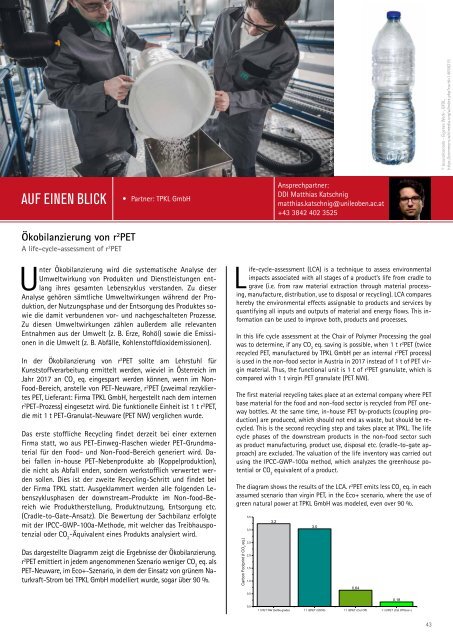Kunststofftechnik Leoben - Zweijahresbericht 2015 - 2016
Sie wollen auch ein ePaper? Erhöhen Sie die Reichweite Ihrer Titel.
YUMPU macht aus Druck-PDFs automatisch weboptimierte ePaper, die Google liebt.
© Alexander Koch<br />
© Jesusalconada - Eigenes Werk-, GFDL,<br />
https://commons.wikimedia.org/w/index.php?curid=14658215<br />
AUF EINEN BLICK<br />
• Partner: TPKL GmbH<br />
Ansprechpartner:<br />
DDI Matthias Katschnig<br />
matthias.katschnig@unileoben.ac.at<br />
+43 3842 402 3525<br />
Ökobilanzierung von r 2 PET<br />
A life-cycle-assessment of r 2 PET<br />
Unter Ökobilanzierung wird die systematische Analyse der<br />
Umweltwirkung von Produkten und Dienstleistungen entlang<br />
ihres gesamten Lebenszyklus verstanden. Zu dieser<br />
Analyse gehören sämtliche Umweltwirkungen während der Produktion,<br />
der Nutzungsphase und der Entsorgung des Produktes sowie<br />
die damit verbundenen vor- und nachgeschalteten Prozesse.<br />
Zu diesen Umweltwirkungen zählen außerdem alle relevanten<br />
Entnahmen aus der Umwelt (z. B. Erze, Rohöl) sowie die Emissionen<br />
in die Umwelt (z. B. Abfälle, Kohlenstoffdioxidemissionen).<br />
In der Ökobilanzierung von r 2 PET sollte am Lehrstuhl für<br />
Kunststoffverarbeitung ermittelt werden, wieviel in Österreich im<br />
Jahr 2017 an CO 2<br />
eq. eingespart werden können, wenn im Non-<br />
Food-Bereich, anstelle von PET-Neuware, r 2 PET (zweimal rezykliertes<br />
PET, Lieferant: Firma TPKL GmbH, hergestellt nach dem internen<br />
r 2 PET-Prozess) eingesetzt wird. Die funktionelle Einheit ist 1 t r 2 PET,<br />
die mit 1 t PET-Granulat-Neuware (PET NW) verglichen wurde.<br />
Das erste stoffliche Recycling findet derzeit bei einer externen<br />
Firma statt, wo aus PET-Einweg-Flaschen wieder PET-Grundmaterial<br />
für den Food- und Non-Food-Bereich generiert wird. Dabei<br />
fallen in-house PET-Nebenprodukte ab (Koppelproduktion),<br />
die nicht als Abfall enden, sondern werkstofflich verwertet werden<br />
sollen. Dies ist der zweite Recycling-Schritt und findet bei<br />
der Firma TPKL statt. Ausgeklammert werden alle folgenden Lebenszyklusphasen<br />
der downstream-Produkte im Non-food-Bereich<br />
wie Produktherstellung, Produktnutzung, Entsorgung etc.<br />
(Cradle-to-Gate-Ansatz). Die Bewertung der Sachbilanz erfolgte<br />
mit der IPCC-GWP-100a-Methode, mit welcher das Treibhauspotenzial<br />
oder CO 2<br />
-Äquivalent eines Produkts analysiert wird.<br />
Das dargestellte Diagramm zeigt die Ergebnisse der Ökobilanzierung.<br />
r 2 PET emittiert in jedem angenommenen Szenario weniger CO 2<br />
eq. als<br />
PET-Neuware, im Eco+-Szenario, in dem der Einsatz von grünem Naturkraft-Strom<br />
bei TPKL GmbH modelliert wurde, sogar über 90 %.<br />
Life-cycle-assessment (LCA) is a technique to assess environmental<br />
impacts associated with all stages of a product‘s life from cradle to<br />
grave (i.e. from raw material extraction through material processing,<br />
manufacture, distribution, use to disposal or recycling). LCA compares<br />
hereby the environmental effects assignable to products and services by<br />
quantifying all inputs and outputs of material and energy flows. This information<br />
can be used to improve both, products and processes.<br />
In this life cycle assessment at the Chair of Polymer Processing the goal<br />
was to determine, if any CO 2<br />
eq. saving is possible, when 1 t r 2 PET (twice<br />
recycled PET, manufactured by TPKL GmbH per an internal r 2 PET process)<br />
is used in the non-food sector in Austria in 2017 instead of 1 t of PET virgin<br />
material. Thus, the functional unit is 1 t of r 2 PET granulate, which is<br />
compared with 1 t virgin PET granulate (PET NW).<br />
The first material recycling takes place at an external company where PET<br />
base material for the food and non-food sector is recycled from PET oneway<br />
bottles. At the same time, in-house PET by-products (coupling production)<br />
are produced, which should not end as waste, but should be recycled.<br />
This is the second recycling step and takes place at TPKL. The life<br />
cycle phases of the downstream products in the non-food sector such<br />
as product manufacturing, product use, disposal etc. (cradle-to-gate approach)<br />
are excluded. The valuation of the life inventory was carried out<br />
using the IPCC-GWP-100a method, which analyzes the greenhouse potential<br />
or CO 2<br />
equivalent of a product.<br />
The diagram shows the results of the LCA. r 2 PET emits less CO 2<br />
eq. in each<br />
assumed scenario than virgin PET, in the Eco+ scenario, where the use of<br />
green natural power at TPKL GmbH was modeled, even over 90 %.<br />
Carbon Footprint (t CO 2<br />
eq.)<br />
3,5<br />
3,0<br />
2,5<br />
2,0<br />
1,5<br />
1,0<br />
0,5<br />
3,2<br />
3,0<br />
0,64<br />
0,18<br />
0,0<br />
1 t PET NW (bottle grade) 1 t r2PET (50/50) 1 t r2PET (Cut Off) 1 t r2PET (Cut Off Eco+)<br />
43


